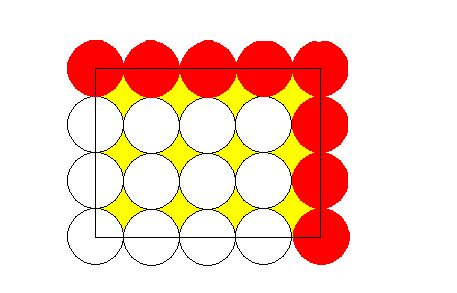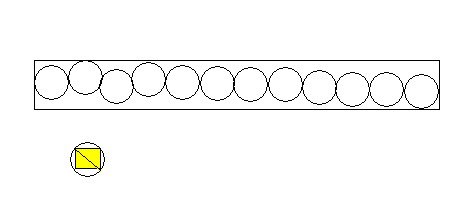-
Posts
871 -
Joined
-
Last visited
-
Days Won
7
Content Type
Profiles
Forums
Events
Gallery
Blogs
Everything posted by Prime
-
The first two turns account for about 8.26% of entire probability. There is 5.48% chance (71/1296) for 12 to win within the first two rolls, and about 2.78% chance (1/36) for 7s to win on the second roll. The remaining 91.74% are split more evenly, but still slightly in favor of 12.
-
That's a nice recursive solution! On the other hand, my infinite series turned out wrong. I am stumped by calculating probability of rolling/not rolling two 7s in a given number of rolls. There seems no way to make a roll independent. Now to the actual calculation of your solution Still, I would take the bet.
-
Oh my! I missed that. Well, since there is no draw, the probability for 12 to show first is 1331/2556, or just over 52%. (Can be calculated as in my original post). Still, I would take the bet.
-
The OP does not state who goes first. So we have to make some reasonable assumption. Mine is: if I got two 7s on my n-th roll and Alex rolled his first 12 on his n-th roll -- that's a draw. Otherwise, you have to make two separate calculations, as the winning chances will dependend on who moves first. For example, if your first two rolls were destined to score 7 each, and Alexe's fate held 12 on his second roll; then if Alex goes first -- he wins, you go first -- you win.
-
It is a close call. Better than most games you find in Las Vegas. Calculating odds is a bit tricky. And there is a possibility of a draw (when you roll your second 7 just as Alex rolls his 12). Regrettably, I do not see my way to calculating the odds without resorting to geometric series. And, I know, Bonanova is going to reprimand me for that. Nonetheless, I am going to stick my head out... I would take the bet at a small stake. The odds are very close. And knowing from the previous Bonanova’s posts that Alex gets sloppy at times with calculating the odds for his bets, taking this bet at a slight disadvantage could make Alex a profitable gambling opponent in future.
-
Whether they bet on heads, or tails has no bearing. However, the winning probability for May (6 coins) is 1/2; for Moe (5 coins) its is less than that. There are 3 possible outcomes: win, loss, draw. And draw has its probability too. Here is another attempt at a simple explanation without using any actual numeric calculations: I suspect, Bonanova may have even simpler formulation.
-
This is an interesting problem. I'll give a partial formula here and the rest, if I have time to formulate it simply. I've met some people who could do a perfect shuffle every time. Some of those spent time in prison and had nothing better to do, but practice. I also noted, some card dealers in Las Vegas come pretty close to perfect shuffle.
-
Sorry, I don't see the proof. I still believe, my illustration shows how 32 plates (additional 20 to the original 12) would always be enough. Conversely, you should be able to give an example of a rectangular table and a plate, where no more than 12 non-overlapping could be placed, but 32 were not to cover the entire table. I mean specific dimensions, like table -- x*y and a plate of radius z.
-
-
So in case of a tie they both go hungry? More to the point, are 5 or 6 coins enough to buy a chocolate malt?
-
(7) could be CRATER, if not for the "L" at the end.
-
Some opinions are more equal than others.
-
In Gödelian basic algebra notation: x ⊃ `x (IF x, THEN NOT x). The above statement is not consistent (perhaps, what you call invalid.) It states a contradiction. There are some statements, which cannot be proven -- the proof leads to an incosistent (contradictory) statement. Whereas, x = -x is a valid algebraic statement and it has a solution (x = 0). So if your proof for the statement "this statement cannot be proven to be true" yielded "true", that would create an inconsistency. On the other hand, if we derived a proof that yielded "false" that would be a contradiction too. The accepted conclusion is rather we cannot have a proof, not that we cannot have the statement.
-
I don't quite follow the "invalid". Does it violate some rule according to which statements must be constructed? If so, what rule? I could understand "invalid logic" where you specifically show some derivation rule that was violated. But how does that apply to "invalid statement"? If in trying to resolve the statement we applied some logic rules incorrectly, we must discard our solution, but not the statement. Gödel's incompleteness theorem is a proof that certain logical systems will necessarily have undecideable propositions. But it does not mean that those propositions cannot be decided outside the system. For example, in the crocodile and baby paradox, we assume that the crocodile is bound by honor to keep his word. Outside of that nothing stops the crocodile from eating the baby. d3k3 already introduced one possible outside system where the statement does not present the dilemma, namely "who cares" system. Other than that, did we come to a conclusion that we have no logic tools at our disposal to resolve the statement? I think, the notion of "proof" is somewhat undefined in our discussion. So "This statement cannot be proven to be true" is ambiguous. Note, in Gödel's work, the "proof", or "demonstration" is defined quite explicitly.
-
-

The liar, the truth teller....and the random answerer
Prime replied to a question in New Logic/Math Puzzles
For help see correct solutions in this topic. One by Writersblock posted first. I gave another one a year later. There may be some more, I didn't go through the entire topic closely. -
Very profound! On a lighter and largely unrelated note, HPLD-s come to mind. (Highest Possible Level of Development beings.) They can be found in the "Cyberiad" -- a collection of short stories by Stanislaw Lem. Specifically, in the one story closer to the end entitled "Altruizine Or a True Account of How Bonhomius the Hermetic Hermit Tried to Bring About Universal Happiness, and What Came of It."
-

The liar, the truth teller....and the random answerer
Prime replied to a question in New Logic/Math Puzzles
You are right. That was not a solution. Nothing works here, unless you eliminate Random teller from one of the positions with your very first question. Here is why... -
Per OP, you don't know whether counterfeit weighs more, or less than true coin. So if one group of 9 weighs less than the other, you are left with 18 coins.
-
I can't even solve the starter example. What kind of color is NDG?
-

The liar, the truth teller....and the random answerer
Prime replied to a question in New Logic/Math Puzzles
This is a good solution! The first question eliminates 2 possibilities out of 6, the second question eliminates two more possible arrangements, and the third question decides between the remaining 2 variations. -

The liar, the truth teller....and the random answerer
Prime replied to a question in New Logic/Math Puzzles
Oops, sorry, I did not notice your last post. So you have caught the error already. Looking through the posts I see that the problem has been solved by Writersblock soon after it was originally posted. I gave a similar solution in my earlier post using a different relation between the Random, Truth-teller, and Liar. I believe the key to the solution is to come up with a question that uses some relation between the men. I think your question "Could C affirm A's answer?" is that type of the question. However, not excluding Random from some position(s) on the very first question makes things difficult. -

The liar, the truth teller....and the random answerer
Prime replied to a question in New Logic/Math Puzzles
I beg to differ. If the arrangement for ABC was RTL, then 1. A, the Random, could have answered truthfully to the first statement, saying that C was not a Random. 2. Your second question directed to B was "Could C affirm A's answer?" Then B, the Truth-teller, knowing that C, the Liar, could not affirm the truthful answer just given by Random. So his reply would also be "No". 3. And the third question 2+2=4 directed to the Liar, would also draw the "No" response. Thus with RTL arrangement, you could receive NNN answers (if Random chose to tell the truth). As well TRL arrangement could produce NNN in case Random spoke the truth.


